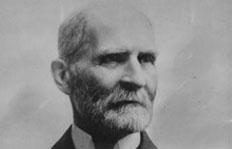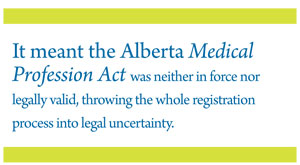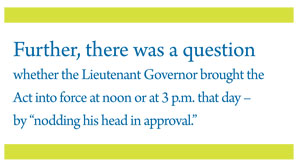Law vs. Licensure: Which shall rule?
Lafferty vs. Lincoln test case an intriguing snapshot in history
January 2, 2014

The provinces of Alberta and Saskatchewan were created by an Act of the Parliament of Canada on July 20, 1905. It was a Canadian precedent. There had never been a "territory" that then became a "province" under the British North America Act of 1867. Nor has there been one since.
A key legal question was whether the Northwest Territories (NWT) institutions, corporations, societies and associations would continue in the two new provinces.
The controversy arose because of Section 16.3 of the 1905 Alberta Act, which states that societies and associations incorporated by the Legislature of the NWT "shall continue to be dissolved and abolished by order of the [federal] Governor in Council [cabinet]."
 On May 18, 1906, Dr. William A. Lincoln registered to practice under the NWT Medical Ordinance. He did not reapply to be grandfathered under the Alberta Medical Profession Act passed by the Alberta Legislature on May 9, 1906, nine days before. His position was that the Medical Profession Act was invalid.
On May 18, 1906, Dr. William A. Lincoln registered to practice under the NWT Medical Ordinance. He did not reapply to be grandfathered under the Alberta Medical Profession Act passed by the Alberta Legislature on May 9, 1906, nine days before. His position was that the Medical Profession Act was invalid.
On October 18, 1906, after the newly elected Medical Council of Alberta met on October 3, it appointed Dr. James D. Lafferty as the registrar. He had been the NWT registrar since 1901 and had drafted the Alberta and Saskatchewan medical acts.
As Dr. Lincoln had not registered under the Alberta Medical Profession Act, Dr. Lafferty initiated legal action against him for practicing without a license. In Calgary on December 20, 1906, the case was heard by police magistrate Crispin E. Smith. At the hearing, Dr. Lincoln agreed that he had been in practice "for gain" on December 13. He also admitted he wasn’t registered under the Alberta Act, but he was under chapter 53 of the Consolidated Ordinances of the NWT of 1898.
The police magistrate found Dr. Lincoln guilty and ordered him to pay a penalty of $1, and $2 for the costs.
The appeal
Dr. Lincoln appealed, alleging the Alberta Medical Profession Act was not in force and never had been. He said it was outside the jurisdiction of the Alberta Legislature to pass such an Act. He alleged the Act could not come into force until the NWT Medical Ordinance was abolished by the federal government. The province, he said, had no authority to dissolve the NWT Medical Ordinance.
 In January 1907, the Supreme Court of the Northwest Territories agreed with Lincoln, citing the Dobie vs. The Temporalities Board case as its precedent, and the "shall continue" clause in the 1905 Alberta Act as its authority. This reversed the police magistrate’s decision. It meant the Alberta Medical Profession Act was neither in force nor legally valid, throwing the whole registration process into legal uncertainty. It also left the NWT Medical Council intact as the examining authority for registration purposes. The NWT court’s decision was not unanimous as Judges Harvey and Stuart disagreed with it.
In January 1907, the Supreme Court of the Northwest Territories agreed with Lincoln, citing the Dobie vs. The Temporalities Board case as its precedent, and the "shall continue" clause in the 1905 Alberta Act as its authority. This reversed the police magistrate’s decision. It meant the Alberta Medical Profession Act was neither in force nor legally valid, throwing the whole registration process into legal uncertainty. It also left the NWT Medical Council intact as the examining authority for registration purposes. The NWT court’s decision was not unanimous as Judges Harvey and Stuart disagreed with it.
The Medical Council immediately met with the Deputy Attorney General B.B. Wood who agreed to join in the appeal to the Supreme Court of Canada. The appeal was led by Drs. Brett, Braithwaite, Simpson, Lafferty and Olson.
As the issue remained sub judice, Saskatchewan physicians continued to act in accordance with and under the authority of the NWT Medical Council, which would have left Dr. Lafferty as its registrar.
The appeal was accepted by the Supreme Court of Canada on February 19, 1907, and heard on April 3, 1907. The decision was handed down on May 7, 1907. It unanimously held that the Alberta Medical Profession Act was valid, and the Legislative Assembly of Alberta had the jurisdiction and authority to pass and implement such an Act. The rationale was that the "shall continue" clause only allowed the NWT Medical Council time to wind up its affairs.
Further, the federal government was not going to interfere by rescinding the NWT Medical Ordinance or interfere with the Legislative purview of the province. The only other jurisdiction that might intercede itself was the English Parliament, which they agreed could, but had not. They interpreted the Temporalities Act as not comparable and therefore not applicable.
Repurcussions
The success of the appeal meant that any incorporated societies or associations established under the NWT ordinances could continue. Lawyers, pharmacists, physicians, veterinarians, architects and dentists all benefitted from the decision and the work of the NWT Medical Council, as did the medical profession of Saskatchewan, who had waited for it.
 The Honorable C.W. Cross, the Attorney General, was delighted, as he had taken a leading role in having the Act passed.
The Honorable C.W. Cross, the Attorney General, was delighted, as he had taken a leading role in having the Act passed.
Dr. Lincoln began his longstanding association with the Alberta Medical Association by becoming a member. He was appointed the secretary-treasurer in 1908. At that convention he gave a paper on "nervousness." How appropriate.
While council’s registration authority was clarified, the possibility of a dual process for registration remained.
On May 9, 1906, a Dr. Steele applied to the Alberta Medical Council to be registered. Dr. Lafferty didn’t accept the application because he wasn’t in the office, as the Alberta Act was being passed in the Legislature. Further, there was a question whether the Lieutenant Governor brought the Act into force at noon or at 3 p.m. that day – by "nodding his head in approval."
Regardless, Dr. Steele was not registered under either Act and chose not to complete another registration application. Instead, he went to his MLA John R. Boyle and applied to have a private members bill passed in the Legislature, entitling him to practice in the province. Steele was a graduate of the University of Pennsylvania and had suitable testimonials to attest to his competence, including working on the Canadian National Railway. Boyle’s private members bill was sent to a committee of the Legislature on or about February 11, 1909.
With Medical Council support, Dr. Lafferty said he was willing to withdraw council’s objections to the bill, providing this was a singular case and neither the committee nor the Legislature would in future override the rulings of the Medical Council. The committee agreed. The bill was passed and Dr. Steele was registered without an examination. It was the first and last such case.
